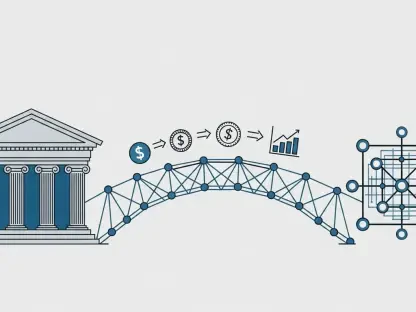Imagine a platform where the collective wisdom of thousands can predict the outcome of a major political election or a significant economic shift with uncanny accuracy, all while allowing participants to profit from their foresight. This is the reality of Polymarket, a decentralized prediction market that has surged to prominence in the blockchain space. Leveraging cutting-edge technology, this platform enables users to trade cryptocurrency on real-world events spanning politics, sports, economics, and beyond. By turning information into a tradable asset, Polymarket offers a unique lens into public sentiment, tying predictions to tangible financial stakes. This guide delves into the intricacies of how the platform operates, the status of its token, the potential for rewards like airdrops, and the strategic roadmap ahead. For traders, investors, or blockchain enthusiasts, understanding this innovative system could provide a significant edge in the fast-evolving landscape of prediction markets.
1. Defining the Prediction Market Innovator
Polymarket stands as a pioneering decentralized platform built on blockchain technology, designed to let users wager on the outcomes of real-world events. Covering a wide array of topics from political elections to economic trends, it operates as an information market where predictions translate into financial positions. Users buy and sell shares based on their forecasts, whether it’s speculating on a cryptocurrency price milestone or the result of a high-stakes election. What sets this platform apart is its ability to aggregate the collective bets of its users, offering a clearer picture of what people truly expect to happen, rather than relying on mere opinions or polls. This approach positions it as a powerful forecasting tool, aiming to foster decentralization, precision, and transparency in how predictions are made and valued. Its recent success in accurately predicting significant events has drawn widespread attention, cementing its reputation as a leader in this niche.
Beyond its forecasting capabilities, the platform also serves as a testing ground for the broader adoption of blockchain-based markets. Its commitment to transparency and user-driven outcomes challenges traditional betting systems, creating a space where information itself becomes a commodity. However, this innovation does not come without hurdles. Regulatory scrutiny, particularly from bodies like the U.S. Commodity Futures Trading Commission (CFTC) regarding registration and user base location, highlights the challenges facing crypto prediction markets globally. These legal considerations make Polymarket a critical case study for how such platforms might navigate complex regulatory landscapes. As decentralized finance (DeFi) continues to grow, understanding the balance between innovation and compliance will be key to the platform’s long-term success and influence in shaping public perception of future events.
2. Understanding the Operational Mechanics
At its core, Polymarket functions on the Polygon blockchain, providing a seamless environment for users to trade shares on event outcomes through a binary “Yes” or “No” system. Share prices, which range from $0.01 to $1.00, directly reflect the market’s perceived probability of an outcome occurring—for instance, a price of $0.70 suggests a 70% likelihood. Unlike traditional betting systems, there are no fixed odds; prices dynamically adjust based on user trading activity. If a prediction proves correct, shares are redeemed at $1 each, while incorrect predictions render them worthless. After an event concludes, decentralized oracles alongside a Market Integrity Committee ensure fair resolution by verifying results, maintaining trust in the settlement process. This structure underscores the platform’s commitment to transparency and user-driven accuracy in prediction markets.
The platform’s reliance on liquidity providers is another critical component of its functionality. These providers supply the necessary capital to ensure markets remain stable, allowing traders to enter or exit positions without causing drastic price fluctuations. Additionally, smart contracts automate transactions, removing the need for intermediaries and thereby reducing costs while enhancing trust through minimized human error. This infrastructure not only streamlines operations but also reinforces the decentralized ethos at the heart of the system. By leveraging blockchain’s inherent security and automation, Polymarket creates a robust environment where users can confidently engage in prediction trading, knowing that funds and outcomes are managed with precision and impartiality, setting a high standard for similar platforms in the DeFi space.
3. Spotlight on the Leadership Team
Driving Polymarket’s vision is a team of seasoned professionals with diverse expertise in technology and finance. Shayne Coplan, the Founder and CEO, launched the platform in 2020, bringing a background in computer science from NYU—though he did not complete his degree. Under his guidance, the platform has experienced remarkable growth, establishing itself as a frontrunner in prediction markets. Liam Kovatch, as Head of Engineering, oversees the technical infrastructure, drawing on experience from prior roles at Paradigm Labs to ensure robust system performance. Meanwhile, Art Malkov, serving as Chief Digital Officer and Chief Marketing Officer, spearheads marketing efforts and digital outreach, crafting strategies to expand the platform’s global presence. This trio forms the operational backbone, steering the company through innovation and market challenges.
Adding to the strategic depth are notable advisory figures. Christopher Giancarlo, a former CFTC Commissioner, has chaired the advisory board since May, offering invaluable regulatory insight during a time of legal scrutiny for crypto platforms. Additionally, Donald Trump Jr. has recently joined the advisory board, bringing a high-profile perspective to the team. This combination of technical prowess and strategic advisement positions Polymarket to navigate both the complexities of blockchain technology and the intricacies of global market regulations. The leadership’s collective experience not only fuels the platform’s growth but also builds credibility among investors and users, reinforcing trust in a sector often marked by uncertainty and rapid change, ensuring the platform remains adaptable to evolving industry demands.
4. Token Status and Financial Operations
Unlike many blockchain platforms, Polymarket currently operates without a native token, a distinction that sets it apart in the DeFi ecosystem. Instead, all trading activities and liquidity rewards are conducted using USDC, a stablecoin pegged to the U.S. dollar. This approach minimizes volatility risks for users engaging in prediction markets, ensuring that the value of their trades remains consistent with real-world currency. By forgoing a proprietary token, the platform focuses on simplicity and accessibility, appealing to a broader audience that may be wary of the complexities associated with fluctuating crypto assets. This decision also reflects a strategic emphasis on user trust and operational clarity, prioritizing market functionality over token-based incentives at this stage of development.
The absence of a native token does not diminish Polymarket’s financial ecosystem, as the use of USDC aligns with its goal of creating a seamless trading experience. Liquidity providers, essential to maintaining market stability, are also rewarded in USDC, ensuring that capital flows remain predictable and reliable. This model supports the platform’s decentralized structure while avoiding the speculative bubbles often tied to new token launches. While some community members speculate about the potential introduction of a token in the future, the current setup allows Polymarket to build a solid foundation focused on prediction accuracy and user engagement. This financial strategy underscores a cautious yet effective approach to scaling within the competitive landscape of blockchain-based markets.
5. Funding Milestones and Valuation Growth
Polymarket’s financial journey reflects strong investor confidence, beginning with a seed round in October 2020 that raised $4 million, led by Polychain Capital. By May 2024, a Series A round secured $25 million with General Catalyst at the helm, alongside Airbnb co-founder Joe Gebbia as a key investor. That same month, a Series B round brought in $45 million, led by Founders Fund, with notable contributions from Ethereum co-founder Vitalik Buterin and firms like 1confirmation, ParaFi, and Dragonfly Capital. These rounds collectively amassed around $70 million by mid-2024, fueling platform development. In October of the current year, the Intercontinental Exchange (ICE), owner of the New York Stock Exchange, invested up to $2 billion, valuing Polymarket at $8 billion pre-investment and potentially $9 billion post-investment, marking a significant leap in market standing.
This substantial funding underscores Polymarket’s growing influence in the decentralized finance sector, positioning it as a heavyweight among prediction market platforms. The ICE investment, in particular, signals institutional trust in the platform’s vision and operational model, providing not just capital but also strategic alignment with established financial entities. Such backing enables Polymarket to expand its technological infrastructure and navigate regulatory challenges with greater resources. The escalating valuation reflects market optimism about the platform’s ability to redefine how predictions are monetized and aggregated. As investment continues to pour in, the focus remains on scaling operations and enhancing user experience, ensuring that financial support translates into tangible advancements for the platform’s global user base and long-term sustainability.
6. Strategic Roadmap and Market Expansion
Polymarket’s future plans highlight a blend of regulatory progress and technological innovation. The platform recently received a no-action letter from the CFTC, easing certain obligations like record-keeping and transaction reporting, facilitating a relaunch of U.S. operations. Earlier this year, the acquisition of QCX, a licensed exchange and clearinghouse, bolstered its regulated presence in the U.S., with ambitions to reach a $10 billion valuation. Additionally, an upgrade in oracle infrastructure from UMA’s Optimistic Oracle V2 (OOV2) to Managed Optimistic Oracle V2 (MOOV2) aims to improve resolution accuracy by restricting proposals to vetted participants, reducing errors and expediting settlements. These steps reflect a proactive approach to enhancing reliability and compliance in a competitive market.
Further strengthening its position, Polymarket has partnered with X (formerly Twitter) to integrate data such as posts, trends, and signals from X’s Grok system into market predictions. This collaboration enriches how probabilities are displayed and understood, offering users deeper contextual insights. The strategic moves toward U.S. market re-entry and technological upgrades signal a clear intent to solidify trust and expand reach. By addressing both regulatory and operational challenges head-on, the platform is carving a path toward mainstream adoption. These developments not only improve user experience but also position Polymarket as a frontrunner in blending real-world data with decentralized forecasting, potentially setting new standards for how prediction markets operate on a global scale.
7. Engaging with Platform Rewards
Although no airdrop has been officially announced, users can still participate in Polymarket and earn rewards through active engagement. The process begins by visiting the platform’s website and signing up with an email or crypto wallet, a straightforward step to join the ecosystem. Next, funding an account with USDC allows users to start trading on various event outcomes. Selecting a category of interest—be it politics, sports, or economics—and placing bets on predicted results is the core of the experience. Finally, checking the daily rewards section to view and complete available tasks offers additional benefits. These steps provide a practical way to interact with the platform and potentially prepare for any future reward programs that might be introduced, keeping users actively involved in the prediction market space.
This engagement model encourages users to dive into the mechanics of prediction trading while reaping immediate benefits from their participation. The absence of a confirmed airdrop does not detract from the value of exploring the platform, as daily tasks and trading rewards offer tangible incentives. By following these steps, users gain hands-on experience with decentralized markets, learning to navigate share pricing and outcome probabilities in real time. This process also builds familiarity with blockchain-based trading systems, which could prove advantageous if future initiatives like airdrops or token launches emerge. For now, the focus remains on leveraging current opportunities within Polymarket to maximize returns and deepen understanding of how decentralized prediction platforms function in a dynamic financial landscape.
8. Airdrop Withdrawal and Token Event Updates
As of now, there has been no official announcement regarding an airdrop on Polymarket, meaning withdrawal processes for such rewards are not applicable at this time. Users anticipating potential distributions should stay updated through the platform’s official channels for any future developments. Without a confirmed airdrop, the focus remains on engaging with existing trading and reward mechanisms to benefit from the platform’s offerings. This lack of immediate airdrop news does not diminish the value of participation, as the platform continues to provide opportunities through prediction markets. Keeping informed about updates ensures that users are prepared for any new initiatives that might introduce additional ways to earn or withdraw rewards in the evolving DeFi space.
Similarly, no date has been confirmed for a Token Generation Event (TGE), leaving the timeline for a potential native token launch uncertain. While community speculation persists about the introduction of a token, the current operational model using USDC remains the standard for transactions and rewards. Staying connected with official announcements is crucial for users interested in such developments, as a TGE could significantly alter the platform’s ecosystem. Until concrete information emerges, the emphasis should be on utilizing the existing framework to explore prediction trading. These updates, or lack thereof, highlight the importance of patience and active monitoring in a sector where innovation and policy changes can shift rapidly, impacting how platforms like Polymarket structure their financial and user engagement strategies.
9. Reflecting on a DeFi Trailblazer
Looking back, Polymarket has carved a niche as a transformative force in decentralized finance, redefining how real-world events are predicted and monetized through blockchain transparency. Its ability to turn information into a tradable asset via crowd wisdom stands as a testament to the power of decentralized markets. Major partnerships with entities like ICE and X, alongside a clear trajectory toward mainstream acceptance, mark significant milestones in its journey. Despite the absence of a native token or confirmed airdrop, a thriving community and ambitious global expansion efforts underscore its potential. The platform’s transparent prediction markets, real-time insights into public sentiment, and institutional backing are key strengths, though challenges like regulatory ambiguity and reliance on oracle accuracy persist as hurdles.
Moving forward, stakeholders and users should focus on monitoring regulatory developments, especially in critical markets like the U.S., to anticipate how compliance might shape future operations. Exploring the platform’s current offerings provides a practical way to engage with decentralized forecasting while awaiting updates on tokens or additional rewards. Strengthening personal understanding of market dynamics and blockchain technology can position users to capitalize on upcoming opportunities. As Polymarket navigates volatility risks and oracle dependencies, its commitment to innovation offers a blueprint for the prediction market sector. The path ahead lies in leveraging these lessons to advocate for clearer regulations and enhanced technological safeguards, ensuring that such platforms continue to redefine forecasting with trust and precision at the forefront.









